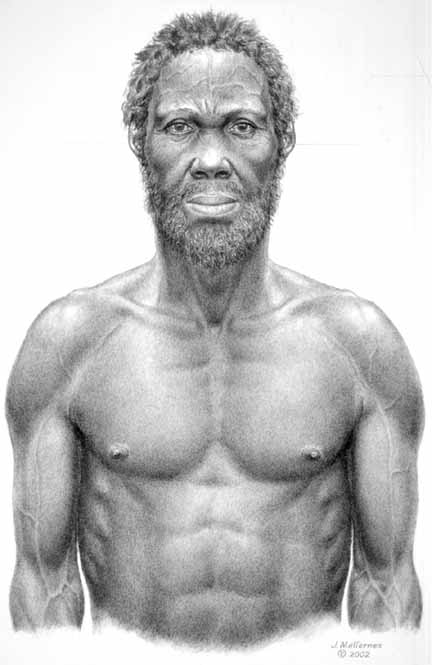




Modern Humans
270,000 y.a. __Perry's DNA suggests modern humans were emerging before 270,000 years ago.
195,000 y.a. __The Omo Kibish people were living in Africa.
160,000 y.a. __Homo sapiens idaltu , modern humans, developed.
133,000 y.a. __Start of the Abbassia Pluvial wet period in the Sahara
Anatomically Modern Humans, abbreviated AMH, developed. These may have now been classified as Haplogroup A00.There were two enormous volcanic eruptions over a span that includes the AMH emergence. The eruptions were Haroharo, 280,000 y.a. and Whakamaru, 254,000 y.a. Two such enormous eruptions had worldwide effects on the flora and fauna and on the evolution of humans. The "volcanic winter" lasting centuries would have pruned the family tree back to a few especially hardy and well-situated bands, so 'founder effects', the driver of evolution, was a major factor in the emergence of the AMH.
195,000 y.a. __The Omo Kibish people were living in Africa.
Fossils 195,000 years old have been found at the Omo Kibish site in Ethiopia. These are the oldest AMH fossils found so far. Eventually it may be proven that these the founding Haplogroup A0 fossils. (Perhaps there should be a term Homo sapiens omo for these people).190,000 y.a. __The first(?) of several migrations of modern humans from Africa
They took the northern route across the Sinai. These modern humans colonized much of Eurasia during several of the long wet periods in the 20,000 year long North African climate cycle, leaving fossils that present intriguing questions about interbreeding and development of these early modern humans.185,000 y.a. __Modern(ish) humans were living in Misliya cave near Haifa, Israel.
160,000 y.a. __Homo sapiens idaltu , modern humans, developed.
The fossilized remains of H. s. idaltu were discovered at Herto Bouri near the Middle Awash site of Ethiopia�s Afar Triangle. These specimens are argued to represent the direct ancestors of modern Homo sapiens sapiens. They were AMH - Anatomically Modern Humans. They were not the knuckle-dragging stereotypes of 'cavemen', but were esentially just like us. There were some differences in their bones, their skin was brown, blonds were very rare, and blue eyes did not exist.133,000 y.a. __End of the Saale ice age. Beginning of the Eemian Interglacial Warm Period.
Founded as Haplogroup A, continuing diversification of the gene pool led them through the sequential development of Haplogroups A1 and A1b.
133,000 y.a. __Start of the Abbassia Pluvial wet period in the Sahara
It was a wet period that caused the Sahara and the Sinai to bloom with lush vegetation fed by lakes, swamps, and river systems. This unblocked the route north out of Africa. The route stayed open for 30,000 years. These wet cycles occurred several times and are the basis of the "Sahara Pump Theory" about how the earlier people were able to cross what is now a very harsh route out of Africa several times in relative comfort.125,000 y.a. __Modern humans living outside Africa
Modern humans were living in Qafzeh and Es-Skhul caves near Nazareth and Haifa, Israel and at Jebel Faya, 40 km southeast of Dubai. The Skhul/Qafzeh hominids had died out by 80,000 years ago because of drying and cooling conditions of the Weichselian ice age.115,000 y.a. __The " Last Glacial Period ", the lethal Weichselian Ice Age began its advance.
This long, extremely severe ice age drove all of the human settlements of the various earlier "Out of Africa' migrations to extinction. They left fossils, tools, and archaeological evidence, but no known surviving descendants except for perhaps a few hybrid Neanderthals in Europe and, in Asia, some Denisovans and H. erectus groups.Meanwhile, back in Africa:
115,000 y.a. __Haplogroup BT emerged from Haplogroup A1b.
100,000 y.a. __Haplogroup CT evolved from Haplogroup BT
